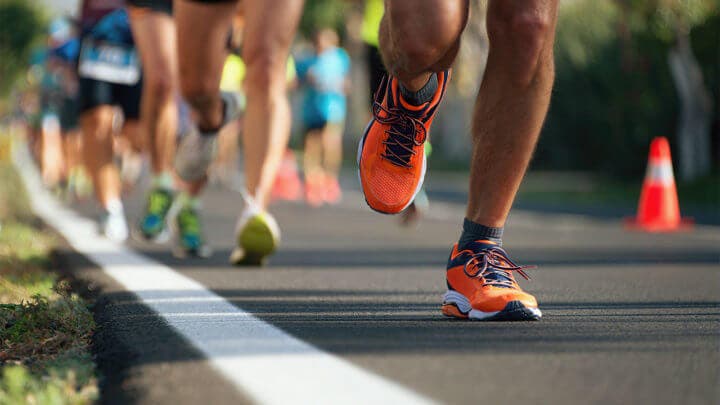The human body is an engineering design thought to the millimeter. It is capable of making us endure days without sleep and strength training out of the ordinary. But resistance has a limit. And we have found it.
Until recently there was no clear answer about the limits of physical endurance of the human body , especially in those who exercise to participate in high-competition sports, but researchers at Duke University have compared various sporting events to weigh in what moment the body goes beyond its limits.
2 things have been discovered. The first, that the limit of human resistance depends on the duration of the event. It makes sense: you can handle a 10-kilometer run one day, but on the third day you’re not going to keep up the same pace, right? The second, that this limit is 2.5 times the basal metabolic rate.

What is the basal metabolic rate?
It is an indicator that is used to find how many calories your body burns when it is at rest . This calorie burn comes from breathing, heartbeat, and even thought.
The first thing would be to calculate what our BMR (Basal Metabolic Rate) is. The formula for men involves multiplying your weight in kilos by 10, and to that adding the result of multiplying your height in centimeters by 6.25, subtracting your age by five and adding five to the final number. Or what is the same, (10 x weight in kg) + (6.25 x height in cm) – (5 x age in years) + 5.
Take for example a 35-year-old man who is 1.85 and weighs 90 kilos. The formula would be (10 x 90) + (6.25 x 185) – (5 x 35) +5. If we do the parentheses, we are left with 900 + 1,156.25 – 175 + 5. The result would be 1,886.25.
A person who does little or no exercise needs to consume his BMR x 1.2. Therefore, the man in our example would need to consume 2,263.5 calories a day as long as he is not physically active.
As we have said before, the limit is 2.5 times our BMR. Therefore, when this man has consumed 4,715.6 calories (his BMR, 1886.25, x 2.5), his body will have reached the limit.

How to assess the limit of physical endurance
The study began with the “Race across the United States”, in which athletes travel about 4,956 kilometers from the state of California to the city of Washington over 140 days.
Participants in the competition ran 6 marathons a week for almost 4 months. The researchers looked at the effects this had on their bodies. For example, their resting metabolic rate was measured before and during the race. In addition, the calories they burned when they were at the peak of the competition were measured.
The study showed that energy use was consistently fairly high, but leveled off when it reached 2.5 times the resting metabolic rate. That is, regardless of the sporting event, energy expenditure stabilizes sharply after about 20 days, and finally stabilizes at approximately 2.5 times the resting caloric expenditure of an athlete (Thurber et al., 2019).
According to the researchers, at that point the body is burning calories more quickly from food than it can absorb and convert them into energy, representing a biologically determined ceiling in human performance. That is, it is impossible for the body to overcome it, because beyond it, it is impossible for the body to digest, absorb or process enough calories to sustain such a high level of energy consumption.

Human physical endurance required for a marathon
This means that while you may be burning more calories at the beginning of these types of events, everything stabilizes eventually. This analysis, published in the scientific journal Science Advances , also found a pattern between the duration of a sporting event and energy expenditure: running a marathon may be an excessive effort for many people, but it is not close to the limit of human endurance. .
“People can exercise vigorously for a couple of days, but if you want that resistance to sustain, you have to lower the intensity of the exercise,” says Herman Pontzer of Duke University.
But not only sports push us to the limit: the study also showed that during pregnancy the energy expenditure of some women reached 2.2 times the resting metabolic rate. Thinking about pregnancy in the same terms that we think about cyclists and triathletes makes you realize how incredibly demanding pregnancy is on the body.

Power and physical endurance limit
The researchers argue that the cutoff of 2.5 has much more to do with the digestive system than it does with the endurance of the heart, lungs, and muscles.
Diet is extremely important to sustain yourself in any endurance event. According to the American College of Sports Medicine , you should consume 30 to 60 g of carbohydrates per hour of exercise if you exercise for more than an hour. In addition, the consumption of electrolytes such as sodium should also be consumed if you exercise for more than an hour (Costill, Greenleaf, Montain and Noakes, 1996).
But since our bodies cannot absorb nutrients beyond a certain point, even if more food is eaten during a long and grueling run, the calories ingested beyond that limit would be wasted.
“Gastrointestinal problems are likely, but most likely the person simply feels unable to continue eating,” he said. Because of this, there comes a point where it’s impossible for humans to break records, because they can’t absorb enough nutrients to fuel their bodies after a certain point, and as we all know, if you don’t get the fuel you need, your performance could drop. plummeting.
In short events, the body can make use of its own resources – burning fat or muscle mass that is later recovered – to respond to that use of energy. But in extreme events – at the limits of human fatigue – the body has to balance its energy consumption so as not to collapse.

What happens when we exceed the human endurance limit?
In short, we will cross the threshold of the maximum possible level of effort that we can endure in the long term. The long-term is important, because in short periods we can overcome this line, and a lot.
According to the study, published in the journal Science Advances , when we have burned those 2.5 times the basal metabolic rate, our body will start pulling fat and muscle to keep up (Thurber et al., 2019).
Many would think that they could compensate for this by eating a lot, but another of the study’s findings is that this is not the case. Although it is clear that those who exercise need more gasoline than those who do not, when that magic number of 2.5 is exceeded, the body cannot digest, absorb or process more nutrients and begins to break down tissues to compensate.

References
- Costill, D., Greenleaf, J., Montain, S. and Noakes, T. (1996). Exercise and Fluid Replacement. American College of Sports Medicine Position Stand: doi: 10.1100032 / wil88043_appendixk
- Thurber, C., Dugas, L., Ocobock, C., Carlson, B., Speakman, J. and Pontzer, H. (2019). Extreme events reveal an alimentary limit on sustained maximal human energy expenditure. American Association for the Advancement of Science. doi: 10.1126 / sciadv.aaw0341
